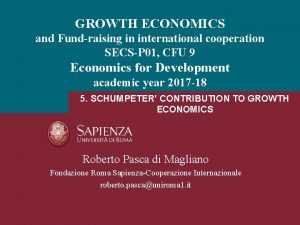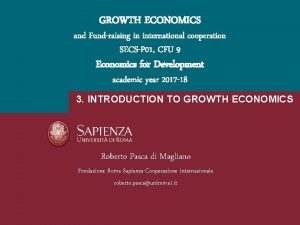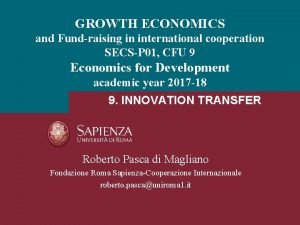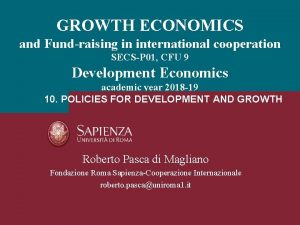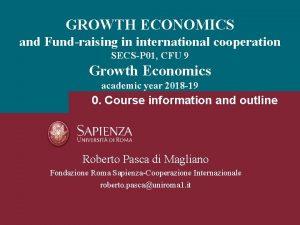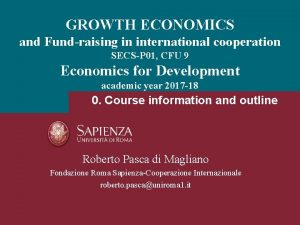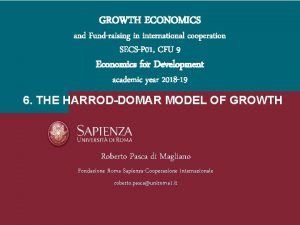GROWTH ECONOMICS and Fundraising in international cooperation SECSP














- Slides: 14

GROWTH ECONOMICS and Fund-raising in international cooperation SECS-P 01, CFU 9 Economics for Development academic year 2017 -18 5. SCHUMPETER’ CONTRIBUTION TO GROWTH ECONOMICS Roberto Pasca di Magliano Fondazione Roma Sapienza-Cooperazione Internazionale roberto. pasca@uniroma 1. it

Joseph Alois Schumpeter introduction • At the beginning of the 20 th century, the dominant doctrine was the neoclassical economics – Marshall, British economist at Cambridge, had great influence on the development of economic thought with theories of costs, value, and distribution and developed a concept of marginal utility. His book Principles of Economics from the year 1890. • Joseph Alois Schumpeter, a member of the German Historical School, developed his idea concerning the role of the entrepreneurship and started his academic career in Vienna. • Publishing Theory of Economic Development in 1934 in which: – tried to introduce the entrepreneurs’ role into the neoclassical economics. – distinguish innovation as the function of the entrepreneur. • Schumpeter has been mentioned as the father of entrepreneurship and of growth theories. Roberto Pasca di Magliano Pagina 2

Schumpeter main issues • Innovations are function of the entrepreneur activity. • Multinationals role (MNCs) as powerful players in the global markets mainly in commodities • Radical innovation in the production process are needed to expand enterprises and to improve behaviour • Entrepreneur: – as innovator, creates profit opportunities by devising a new product, a production process or a marketing strategy but not define what an entrepreneur looks like. – They create innovations in the face of competition and thereby generate (irregular) economic growth Roberto Pasca di Magliano Pagina 3

Schumpeter role of the entrepreneurs • • Innovations are considered as the major driver of an economy Since the social returns of innovations exceed the private returns the factors innovativeness is considered crucial aspect to policy makers in any of market economies. Entrepreneur is motivated by the temporary monopoly profit that is the return on the entrepreneur of the innovation that leads to increased productivity and is the fundamental source of wealth in a society. Distinction between – invention -> an idea made manifest, and – innovation -> ideas applied successfully in practice. • The key to innovativeness is to allow firms to appropriate more of the social benefits of their new products or processes through intellectual property rights or relaxing post-innovation Roberto Pasca di Magliano Pagina 4

Schumpeter distribution of innovation • Innovations are not continuously distributed in time, but proceed by leaps which upset the existing equilibrium in markets and generate (irregular) economic growth • Innovative transformation are a relatively slow and conflict-ridden process and therefore innovation are defined as the function of entrepreneur that is separate from the administrative function of manager • Cycle’s fluctuations are caused by supply shifts based on uneven technological changes Roberto Pasca di Magliano Pagina 5

Schumpeter innovation and competiveness • Entrepreneurs create radical innovations in the face of competition. His notion has been generally accepted. • In Schumpeter’s economic system, business cycles waves are the major catalyst of economic growth. • Typology of business cycles are proposed according to their periodicity, so that a number of particular cycles were named after they are discovered • Although Schumpeter’s theory of business cycles is difficult to apply to the global economy, there is no doubt that the ongoing technology revolution will impact on the global markets Roberto Pasca di Magliano Pagina 6

Schumpeter evidence on the role of technological progress • Comparing the growth of GNP with R&D statistics, it can be noticed that since the shock of the oil crisis in the mid 1970 s the growth of R&D expenditures in the industrialized countries has been approximately double higher than the growth of GNPs. • This trend has accelerated during the two decades of globalization, the 1990 s and the 2000 s. • The revolution of information technology (ICT) was the major source of Schumpeterian dynamics in the industrialized countries in the 1990 s. Roberto Pasca di Magliano Pagina 7

Schumpeter creation vs destruction: some evidence • In the early 90 s, Finland was hit by serious crisis in the bank industry and about 20% of the firm population was lost. During the crisis the positive entrepreneurial event was the unexpected global success of Nokia. • Two decades later Nokia is in a crisis showing a new kind of contemporary creative destruction. • In the some EU countries still in economic difficulties (Greece, Italy, Spain, Portugal and Ireland) the Schumpeterian market shock may be in full force. The negative end results are already known by economists. Hopefully, the positive end results are somewhere waiting for the growth boom in the near future. Roberto Pasca di Magliano Pagina 8

Schumpeter approach to innovation • Two different approaches: – role of entrepreneurs entering in the market niches. Due to the innovation, entrepreneurs challenged existing firms through a process of “creative destruction”, which was regarded as the engine of economic progress. – key role of large firms as engines for economic growth by accumulating non-transferable knowledge in specific technological areas and markets. There is a strong positive feedback loop from successful innovation to increase R&D activities leading to market concentration Roberto Pasca di Magliano Pagina 9

Schumpeter creative destruction • Creative destruction is associated with innovation of entrepreneurs entering unexplored market where there are low entry barriers for new entrants • According to Schumpeter, the "gale of creative destruction" describes the "process of industrial mutation that revolutionizes the economic structure from within, destroying the old one and creating a new one" • Creative destruction is a microeconomic process by itself even if it has considerable macroeconomic implication for growth • It creates economic discontinuities, and in doing so, an entrepreneurial environment, appropriate to the introduction of an innovative process and then helping firms to earn monopoly profits. • Competition is a self-destructive mechanism that normalizes profits when the innovation effect has been utilized. Roberto Pasca di Magliano Pagina 10

Schumpeter creative accumulation • Creative accumulation is associated with institutionalized innovation by MNCs that carry out innovation along established technological trends and even try to prevent the entrance of newcomers. • MNCs – dominate global commodity markets by providing worldclass technologies and logistics, – are important partners for local entrepreneurs – are claimed to utilize monopoly power to create high barriers to entry of competitors – have an impact on industry life cycles and market structure Roberto Pasca di Magliano Pagina 11

Schumpeter creative accumulation: evidence • When entrepreneurs under creative destruction draw from the public domain only to place their own innovations within the reach of imitators, large firms use creative accumulation in order to appropriate innovative knowledge through in-house R&D departments. • Thomas Edison (1847 -1931) owned over one thousand U. S. patents: – himself was a pioneer investor creating technological breakthroughs. In the 1890 s he established General Electric (GE). – GE was among the first ones organizing creative accumulation built on its proprietary knowledge stocks through well-organized R&D departments, including lighting, transportation, power transmission, and medical equipment. – GE is still continuing the infinite quality-improvement process Roberto Pasca di Magliano Pagina 12

Schumpeter R&D expenditure • The heterogeneity of industries is the reason why the relation between concentration and innovative output has been often found to be non-significant or even negative • Relying on historical analyses, the strategy process is the key managerial innovation by which large firms integrate the core elements of vertical production system and create a value chain • Large firms with integrated manufacturing and R&D can be successful in generating radical product and process innovations although MNCs frequently adopt the “escape competition” strategy in the global patent race. Roberto Pasca di Magliano Pagina 13

Schumpeter Human capital role The introduction of innovations opens the door to a deep transformation of the society ØSchumpeter strongly believed in human incentive in innovation dynamics as Robert Lucas (first theorist of the endogenous growth) would point decades later (80 s). ØFollowing the notion of increasing return, Paul Romer (1989) claimed that every generation underestimate their potential role for finding new ideas. Ø technology is not a mysterious outside force, as economists thought in the past, but an internal force that can be cultivated to increase growth. His main slogan, recalling Schumpeter, has been: “The emerging economy is based on ideas more than objects”. Ø The greatest innovations are likely to occur from the cross-fertilization of sectors and professions. For example, artists/ scientists and businessmen work-models are interrelated but different one from the other. A major difference is that artists/ scientists are more likely to think laterally and holistically, while businessmen are linkers of people and concepts owning a linear thinking pattern Roberto Pasca di Magliano Pagina 14
 Secsp
Secsp Fundraising growth platform
Fundraising growth platform International fundraising consultancy
International fundraising consultancy Laboratory accreditation
Laboratory accreditation Working group on international cooperation
Working group on international cooperation International laboratory accreditation cooperation
International laboratory accreditation cooperation Principles and techniques of fundraising
Principles and techniques of fundraising Fundraising 101 presentation
Fundraising 101 presentation School of business and economics maastricht
School of business and economics maastricht Growth analysis
Growth analysis Monocots eudicots
Monocots eudicots Primary growth and secondary growth in plants
Primary growth and secondary growth in plants Chapter 35 plant structure growth and development
Chapter 35 plant structure growth and development Fundraising script sample
Fundraising script sample Anthony thomas chocolate bars
Anthony thomas chocolate bars
